The AI-Driven Content Strategy: 6 Powerful Prompts for Content Marketing
The post The AI-Driven Content Strategy: 6 Powerful Prompts for Content Marketing appeared first on Orbit Media Studios.

Content marketing is all about the content-audience fit.
You win only if you publish content on the topics your audience needs, in the formats your audience prefers, in the places where your audience spends time, in collaboration with the influencers your audience trusts.
No surprise, AI can be very helpful.
There are many ways that AI can support the content strategy. In this little guide, we’re going to cover just a few. We’ve picked a wide range from audience research to GA4 analysis.
Here are six ways to use AI to develop a content strategy.
- Quick audience insights (persona prompt)
- Draft content mission statement (adapt it for email signup CTAs)
- Engaging social media topics (thought leadership prompt)
- Original research ideas (drive links and SEO outcomes)
- Communities where they hang out (PR and outreach research)
- Topics that align promotion channels (AI analysis of GA4 reports)
In the examples here… I’ll use ChatGPT. Several of the methods require a ChatGPT Plus account, which costs $20 but allows you to upload files. I’ve done testing in Gemini, Claude and Copilot. They all work well. These prompts for AI content strategy work in any LLM.
In the examples here… We’ll pretend to be an outsourced exotic animal veterinary service for busy zookeepers. Sick rhino? We’re here to help.

DALL-E: “Draw a realistic picture of two busy zookeepers who have many animals to take care of.”
1. Quick audience insights
Every great content strategy is built on a solid foundation of empathy. So start with the audience. The better we train the AI on our target audience, the better its responses will be.
There are two main ways to train the AI on our target audience:
- Upload or copy-and-paste your battle-tested personas or ideal client profiles (ICPs)
- Use an AI prompt to generate a draft persona
Once it’s generated, checked and revised, every AI response will be better aligned. You can even transform the AI into a synthetic member of your audience, then ask it anything related to content strategy, day or night. Ask what it searches for, clicks on, listens to, downloads and watches.
The key is accuracy. Start with this prompt from our guide on AI-generated personas. Then check it carefully, edit it, add to it, tweak it.
The “Generate Draft Persona” Prompt:
Create a detailed persona for a [job title] working in [industry/company size/geography] who is responsible for [roles/skills/responsibility]. This individual is facing challenges with [specific challenge/problem/task] and is actively seeking [product/service] to address these issues.
- What are their hopes and goals in solving this problem?
- What are their fears and concerns about finding the right solution?
- What are the emotional triggers that would prompt them to take action or make a decision?
- What are the key decision criteria they consider when evaluating potential partners or vendors?
The draft persona is often quite good. You may see insights that would have been difficult to uncover through stakeholder interviews. But still, spend some time reviewing and revising. Your AI content strategy depends on it.
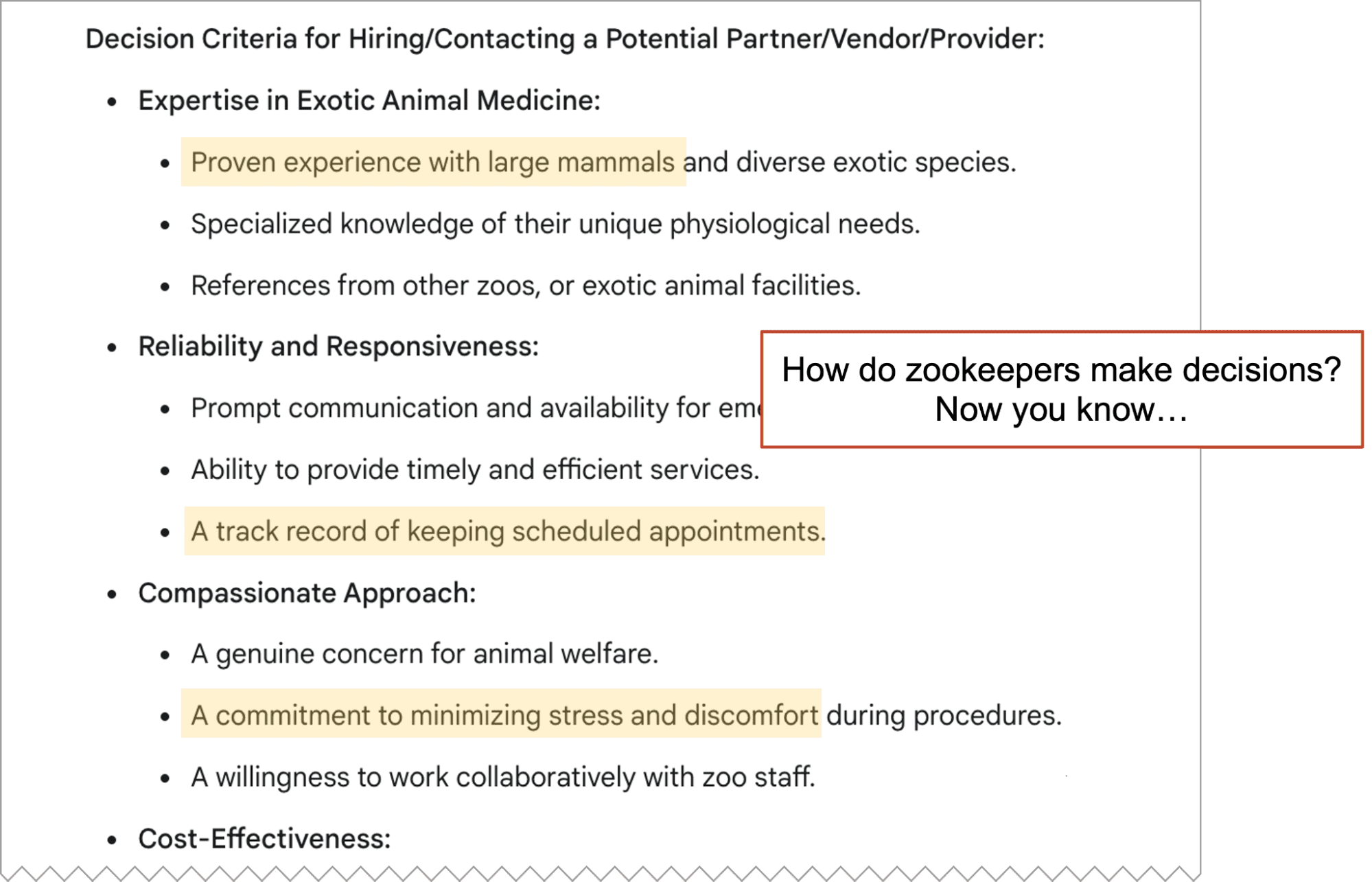
Once this is revised, tested and approved, you can copy it into a separate file, save as a PDF and drop it into any conversation for any AI marketing use case. Or create a custom ChatGPT …or make it a Gemini Gem …or a Claude Project. Then it’s easy to share with the rest of the content marketing team.
 |
John Doherty, EditorNinja“AI is, by default, bad at writing content meant for a specific audience. By turning the AI into an audience member, you will not only write copy that converts better, but you can also decrease the amount of editing needed before the content is ready for publication.” |
Don’t expect AI to provide any useful content strategy insights until you have trained it on your target audience. We often say that until it has your personas, AI = Average Information.
Ready to connect with some zookeepers? Not yet. You may be tempted to start asking AI to write articles and social media posts. But we have more content strategy work to do first.
2. Draft content mission statement (and email signup CTAs)
Let’s lay the foundation of our AI-driven content strategy.
We can use the persona to create a draft content marketing mission statement. This is the concise statement that will guide our content marketing efforts. It includes three main elements: the audience, the information and the what’s-in-it-for-them.
![Text on a dark background: "Our content is where [audience x] finds [information y] for [benefit z]." Logo of Orbit Media Studios is in the lower right corner.](https://www.orbitmedia.com/wp-content/uploads/2025/03/mission-statement-zookeepers.png)
Documenting this keeps you on target, saving you time and wasted energy. It can also help grow your email list because it can be easily adapted into a high-converting email signup call to action.
Here’s the prompt. Drop in the PDF or your persona, or just use this prompt in the same conversion where you generated the persona.
The “Generate Draft Content Mission” Prompt:
You are an expert content strategist with a focus on building trust and attracting qualified visitors. Based on the attached persona, craft a draft content mission statement that aligns with their specific needs and information gaps.
A strong content marketing mission statement includes:
- Target audience: Who is the content aimed at?
- Topics: What specific key themes or subjects will the content cover?
- Benefit to the reader: What value or solution does the content provide?
The mission statement should be clear, concise, and adaptable, especially for use as a call to action to encourage newsletter subscriptions. Then, create three compelling examples of newsletter signup calls to action that resonate with the persona’s interests and drive conversions.
That’s a nice detailed prompt based on many years of content strategy experience. Prompts written by subject matter experts and then shared with less expert team members is a great way to embrace AI.
Let’s review the response:
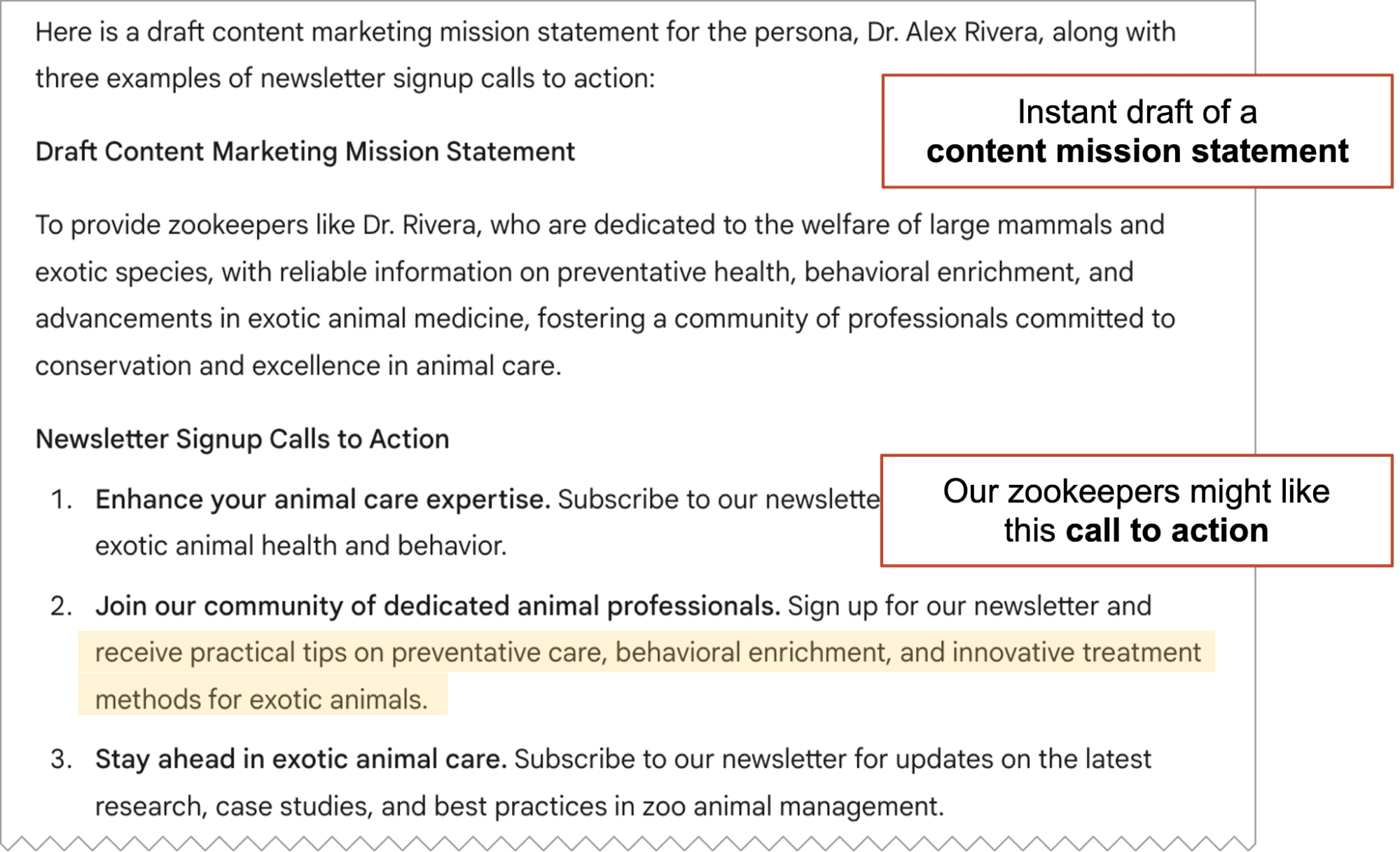
A solid start. The email signup CTAs are nice and specific and specificity is the key to conversions. Edit carefully, but it’s already better than 90% of email signup CTAs on the web. “Signup for our newsletter” is not a good call to action.
Now we’re ready to research specific topics.
This is actually the most common use case for artificial intelligence. Marketers use AI to brainstorm topics more than for writing, editing, images or anything else in digital marketing. Here’s the data from our most recent blogger survey:

Most content on the web is very bland. You may have noticed this.
Look closely at anything published in your category. Is it truly unique to that brand? Or could anyone have written it? What about your own content? Is it different from what others are saying?
There are mostly just two formats for content that are highly differentiated: original research and strong opinions. We’ll cover them both.
3. Discover engaging topics for social media
Online and offline, social interactions are rooted in points of view. Opinions are engaging. They start conversations. Content that comes from a strong opinion is effective in social media for this reason. It triggers response and response triggers social algorithms.
Not all content marketing is thought leadership. In fact most of it is not. True thought leadership takes a position on a topic, and the reader can agree or disagree. If the topic is something they can’t disagree with, it isn’t thought leadership.
Opinionated content is always differentiated, but in the era of AI marketing, it’s even more so. As you read this, content is pouring out of AIs into the blogs of lazy marketers. But that AI generated content isn’t differentiated, because it has no point of view.
AI doesn’t care about anything. But you do.
So let’s take a stand and publish an opinion piece. It doesn’t have to be controversial. In fact, the topic may be very mundane. Let’s find topics that trigger conversation without getting us in too much trouble. For this, AI can help.
The “Provocative-But-Mundane Topics” Prompt:
What are some relatively mundane, almost trivial topics that people in the persona’s industry have very strong opinions about?
Here are the responses based on our Zookeeper persona:
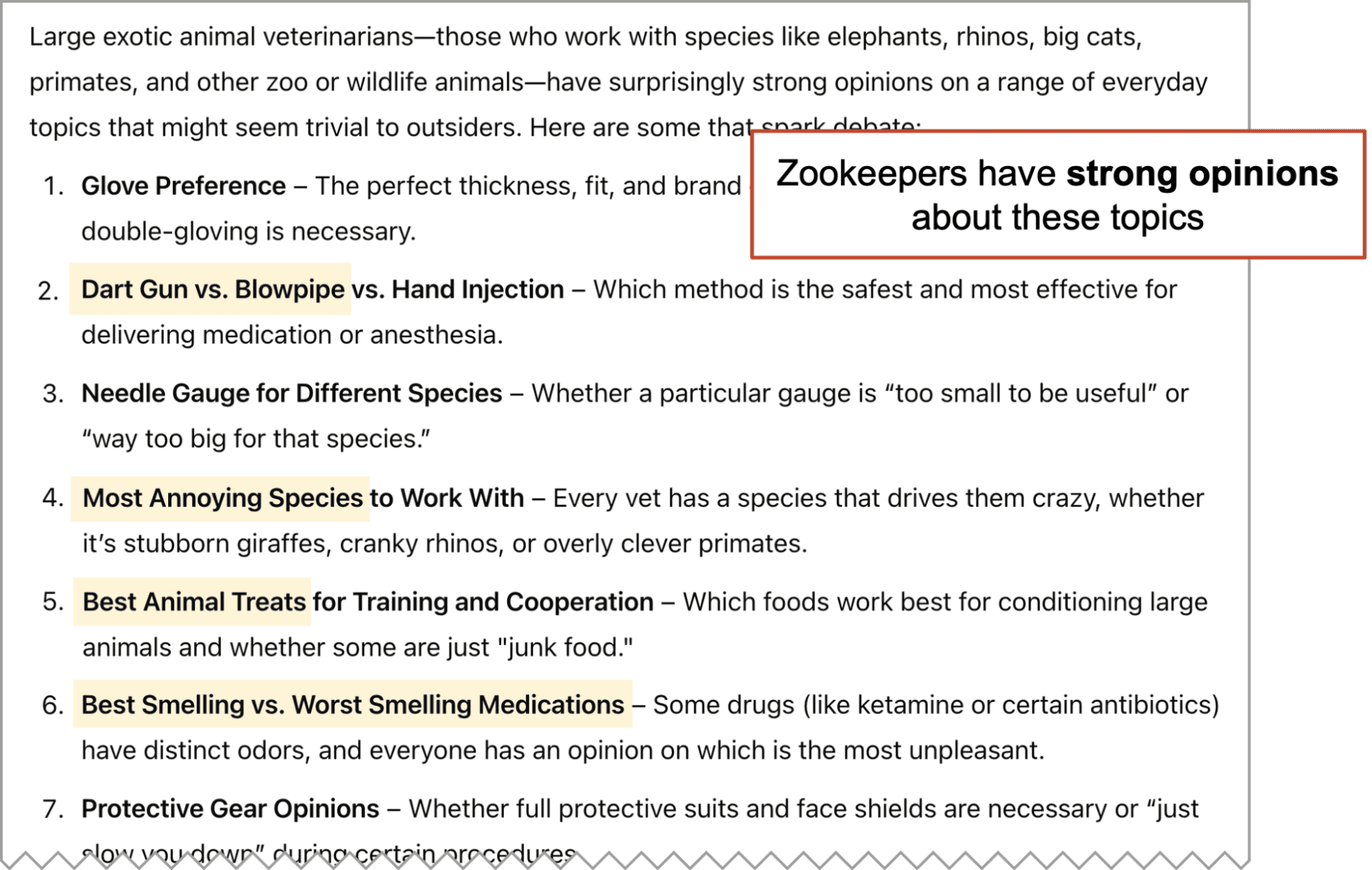
Dartgun vs. blowpipe? Worse smelling medications? Most annoying species? Best treats? None of these topics have right and wrong answers. All of these topics zookeepers have opinions about. This is a gold mine for social media content.
You can find more prompts in our guide for AI-powered thought leadership. One of them reveals the topics that industry blogs aren’t covering. You can use AI to find gaps in the content of the big industry blogs and capture those content creation opportunities. Super fun.
4. Ideas for original research
Here is the other topic that is always highly differentiated. Conduct some new research, publish the data, share your analysis and now your blog is a primary source.
More than any other format in content marketing, research is the kind of quality content attracts journalists’ attention and links. And those links power your search rankings. Original research is at the center of many successful SEO strategies.
Let’s see if AI can suggest some research topics that we could take on. The goal is to publish a statistic that is surprising (let’s bust a myth) or supports everyone’s unsupported assertions (let’s find the missing statistic).
The “Original Research Topics” Prompt:
As a content strategist, your goal is to create original research that attracts press mentions and backlinks from journalists, editors, and bloggers. Your task is to identify new, compelling statistics or insights through research that could strengthen existing claims in the industry.
Focus on uncovering frequently asserted but rarely supported statements within the persona’s industry. These are often the topics that could benefit from original data to validate or challenge common beliefs.
- What are the gaps in existing research where new statistics could add value?
- Which industry claims are widely discussed but lack solid evidence or supporting data?
- How can your original research piece offer unique value and become a credible source for journalists and bloggers looking for fresh perspectives?
Let’s review the responses:
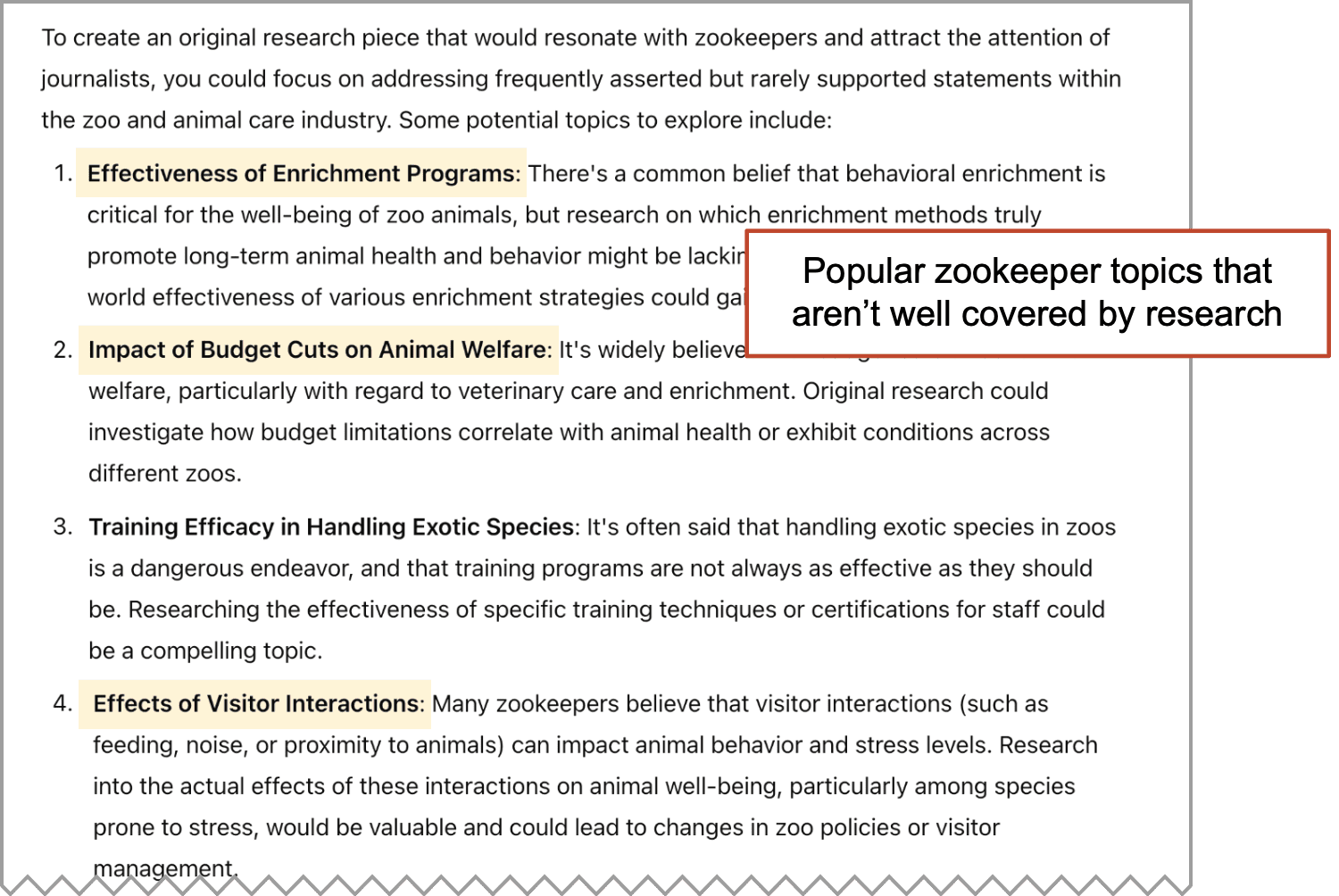
Tackling some of these research ideas would require big budgets and lots of time. We’re doing content marketing here, not medical research. But look closely at the topics. Maybe there’s a story we could tell. If true research isn’t possible, maybe there’s another angle.
If you do conduct a study, however informal or rigorous, here is a list of ways to promote original research. Better yet, collaborate on a study with a group that’s relevant to your zookeepers. What groups are relevant to zookeepers? Let’s find out…
5. Find the communities where your audience spends time
Again, we’ll use the power of AI for research, not writing.
If we know where our audience spends time, we know where to listen and where to engage. We know the publications to pitch to and the events we can attend. We can meet them where they are.
For this, I’ll use a simplified version of Liza Adams “Watering Holes” prompt.
A Simplified “Watering Holes” Prompt:
You are a content strategist marketer who is deeply familiar with the attached persona, including where they tend to congregate. We want to diversify how we reach this market and go beyond the usual digital marketing channels.
We want to identify a variety of “watering holes” where these potential customers learn, engage and interact with each other, so we can target and build relationships with them.
Create a table with the categories of watering holes as rows and the specific watering holes as the cells. (e.g., the actual names of the communities, industry forums, events, groups, marketplaces, webinars, content platforms, partnerships, associations, etc.) Be as comprehensive and specific as possible.
In her original version, the prompt covers more than one vertical, creating a large table with columns for every industry you target. Here we’re focused on one specific persona, so I’ve simplified the prompt to show just the one column.
Here’s the response:
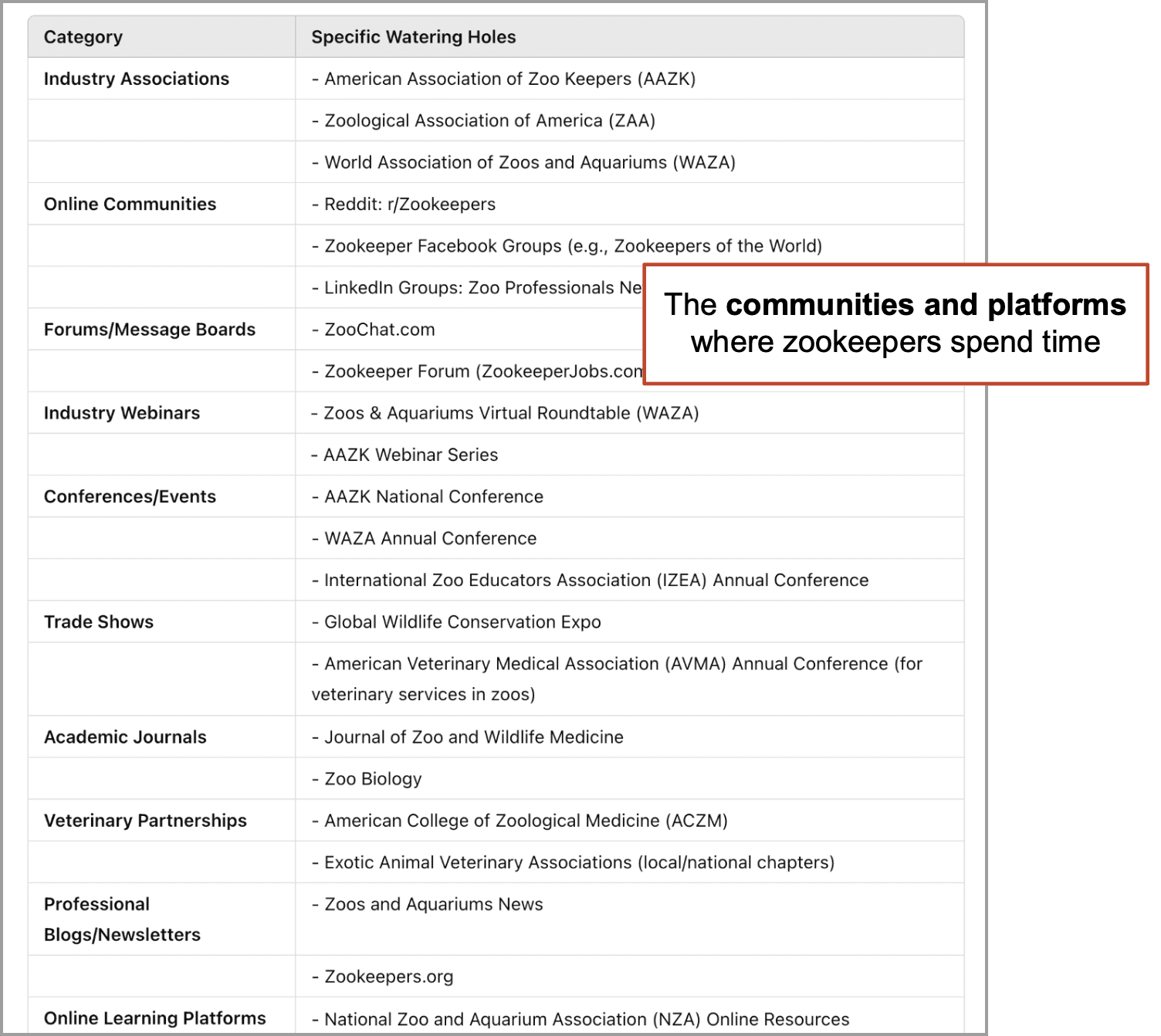
Scan through this list and your head will fill with ideas. Here are just a few to get you started:
- Scan through those communities. Which topics get the most traction?
- Look at the past sessions at those conferences. Have we covered those?
- Check out the editors of those publications. Do we know them yet?
- Who sponsors those tradeshows. Anyone we can partner with?
- Watch some of those webinars. Which influencers does our audience trust?
Even if you’re starting from zero, with no knowledge of this vertical whatsoever, you can quickly see where to start listening. Within an hour of AI-supported research, you may have some great ideas for PR, event participation and influencer marketing.
6. Align topics with promotion channels
Every content strategist knows how important it is to align topics with channels.
Just think about search vs. social. Users of search engines are busy; users of social media are bored. That’s why some topics have opportunities in SEO (detailed answers) and others do great in social networks (surprising and visual).
Here we’ll give AI data from our Google Analytics account, showing which articles (title tags) did how well (traffic and engagement) in which channels (session source). The analysis is done by the artificial intelligence model of your choice. For some LLMs, you’ll need a paid account to upload files.
Use the behavior of your past readers to inform your future content strategy.
First, we’ll get the GA4 report. This is really just one of many ways you can have AI help with data analysis. You can find more examples here.
Use the Pages and screens report set to “Page title and screen class.” You can create a filter to show only blog posts (“Page path and screen class” contains “blog”) and to remove direct traffic (session source does not contain “direct”). Customize to show your favorite metrics (sessions, engagement rate, average engagement time) and export to CSV.
Here’s a screenshot that shows all of the settings. This is the content performance for a blog targeting our zookeepers.
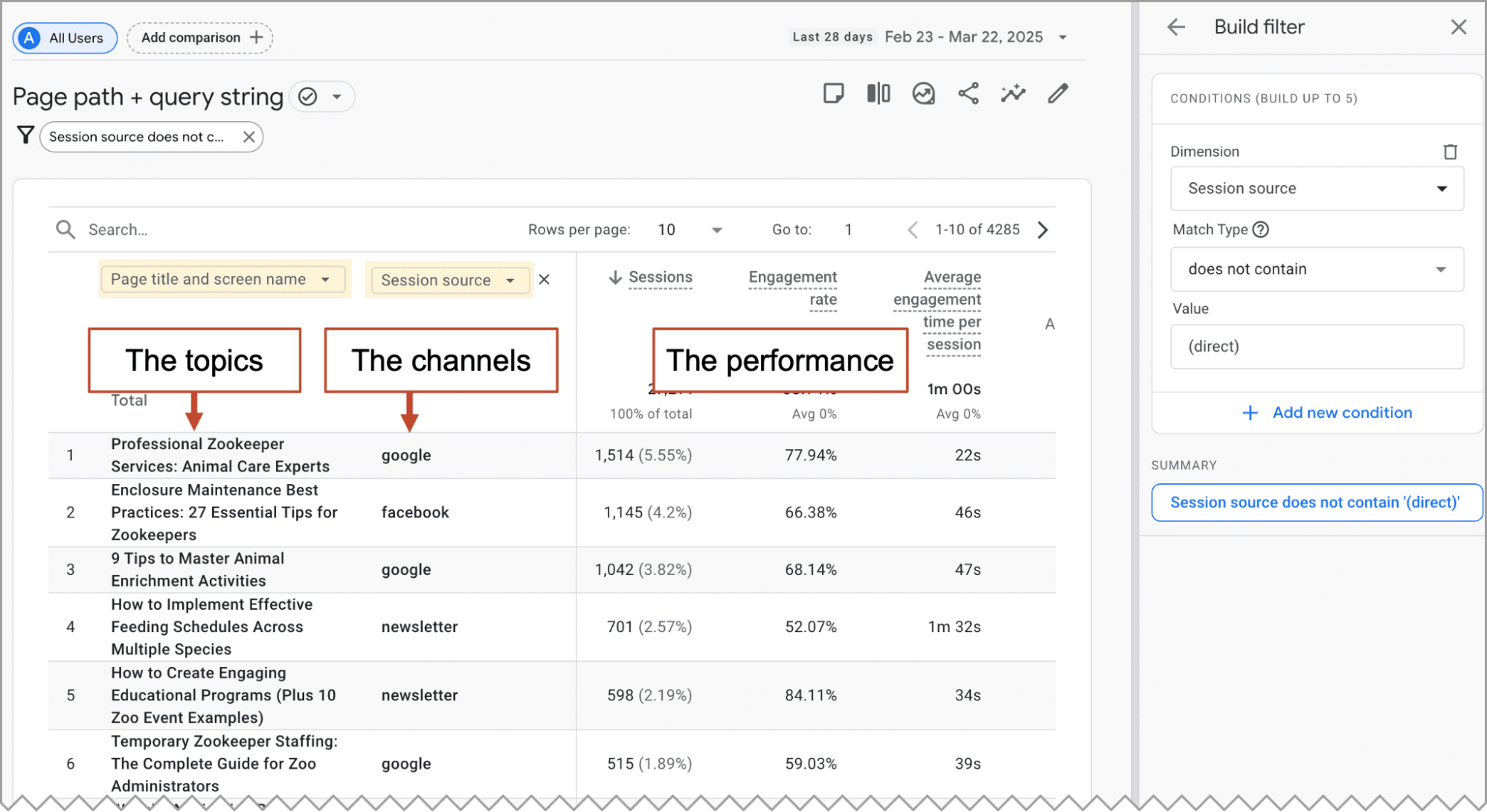
Open the file and delete the first nine rows of comments. Also, remove rows with super low traffic, irrelevant data such as translated titles (non-English) or anything else that’s weird. Save it then upload that to ChatGPT (or any AI tool) with this analysis prompt:
The “Top Channel Alignment” Prompt:
You are a content strategist and Analytics expert, skilled in using data to discover which topics perform well in which channels.
I’m giving you a GA4 report showing the performance of content across various traffic sources on a blog targeting [job title / persona].
Using this data, suggest 10 new topics for articles on this blog aligning topics with the traffic sources in which they are likely to perform well. For each, suggest ways in which it could be promoted in a specific channel.
[upload GA4 report]
Here’s the response for our zookeeper blog:
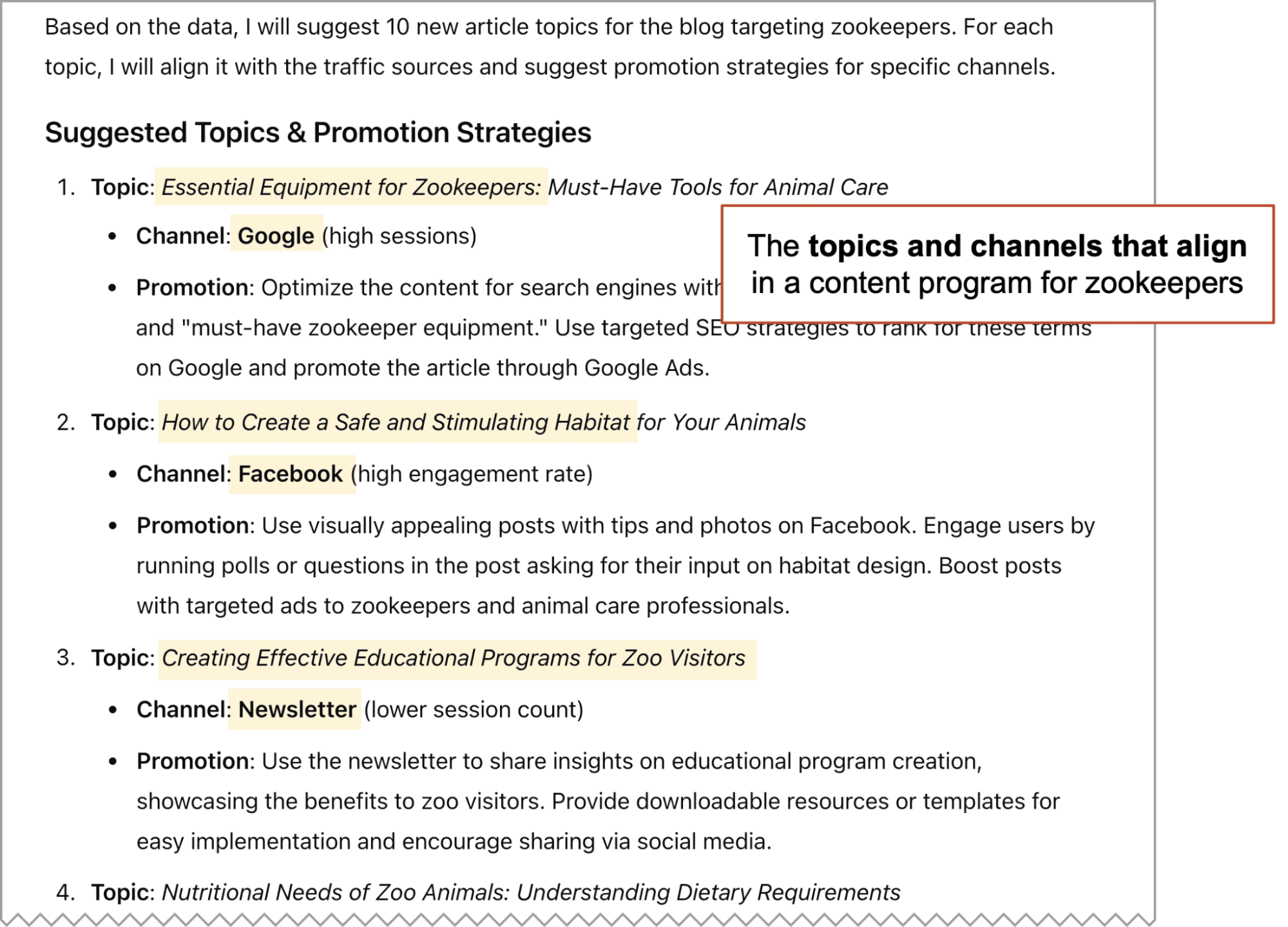
You’re looking at another gold mind.
These topics are closely related to your existing content, they’re aligned with channels, and the AI even gives recommendations for content promotion. This helps the content strategist think ahead to distribution, even before the content creation.
We’ve made the case that AI-driven content strategy is better than AI generated content. Generative AI can support the content creator with content ideas. They can then decide now to apply the insights into the content creation process.
AI gave us a boost, but there’s a lot more to content strategy
Yes, AI can help create a content strategy, but the ideas here were just the foundation. The target and topics are the beginning, but there are many other aspects to content planning and strategy.
- Alignment with business objectives
- Content formats: visual content (videos, infographics), written content (articles, interviews, guides)
- Promotion channels
- Publishing frequency
- Media partners and PR targets
- Influencers, SMEs and collaborators
- Technology and tools (content personalization and predictive analytics)
- Team, partners and workflow
- Success metrics
Imagine how ChatGPT could help with these other aspects of content marketing strategy.
Imagine how the related tasks can get easier, faster and more comprehensive.
But even with the cleverest prompts and the most interesting AI responses, you’ll need to stay involved. Watch it closely. Stay critical. None of those prompts will let you abdicate your job defending quality, filtering out the noise, adding your own perspective, connecting with the partners and ultimately, the prospects.














































































































![Are AI Chatbots Replacing Search Engines? AI vs Google [New Research]](https://www.orbitmedia.com/wp-content/uploads/2025/05/How-often-are-we-using-AI-chatbots_.webp)

















































